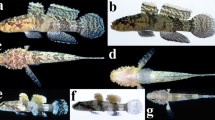Synopsis
The golden hammerhead is a poorly known species of shark that inhabits the northeastern coast of South America from Venezuela to Uruguay. It is found in coastal waters at depths of 9–40 m over muddy bottoms. It is a small species which attains a maximum size of 122 cm and 9 kg. The most distinctive characteristic of this species is its striking bright orange or yellow color. Juveniles less than 80 cm TL are bright yellow or orange; adults are pale yellow. The color is apparently due to pigments present in their diets; juveniles feed primarily on shrimp, while adults feed on fish and catfish eggs. Two pigments have been isolated and their characterization is presently being ascertained. Males mature at about 80 cm TL; females mature at about 98 cm TL. Ovulation and mating occur in August. Gestation appears to last about ten months. Parturition occurs in shallow waters from late May to June. Broods consist of five to twelve young, which measure about 30 cm at birth. The ovarian cycle runs concurrently with the gestation cycle, so it is likely that females are fertilized shortly after parturition, and that the species reproduces yearly.
Similar content being viewed by others
References cited
Alcock, A. 1890. Observations on the gestation of some sharks and rays. J. Asiatic Soc. Bengal 59 (part 2): 51–56.
Clark, E. & K. von Schmidt. 1965. Sharks of the central gulf coast of Florida. Bull. Mar. Sci. 15: 13–83.
Clarke, T.A. 1971. The ecology of the scalloped hammerhead shark, Sphyrna lewini, in Hawaii. Pac. Sci. 25: 133–144.
Compagno, L.V.J. 1984. FAO species catalogue. Vol 4. Sharks of the world. An annotated and illustrated catalogue of sharks species known to date. Part 2. Carcharhiniformes. FAO Fish. Synop. 125, Vol 4, Pt. 2: 251–655.
Cervigon, M.F. 1961. The marine fishes of Venezuela. Sociedad de Ciencias Naturales la Salle, Caracas, 2 vols. 951 pp. (in Spanish).
Gilbert, C.R. 1961, First record for the hammerhed sharkSphyrna tudes in U.S. waters. Copeia 1961: 480.
Gilbert, C.R. 1967. A revision of the hammerhead sharks (Family Sphyrnidae). Proc. U.S. Nat. Mus. 119 (3539): 1–88.
McEachran, J. & B. Seret. 1987. Allocation of the name Sphyrna tudes (Valenciennes, 1822) and status of the nominal species Sphyrna couardi Cadenat, 1951 (Chondrichthyes, Sphyrnidae). Cybium 11: 39–46.
Robins, C.R., C.E. Bond, J.R. Brooker, E.A. Lachner, R.N. Lea & W.B. Scott. 1980. A list of common and scientific names of fishes from the United States and Canada. Special Publication 12, Amer. Fish. Soc., Bethesda. 174 pp.
Schlernitzauer, D. & P. Gilbert. 1966. Placentation and associated aspects of gestation in the bonnethead shark, Sphyrna tiburo. J. Morph. 120: 219–232.
Sadowski, V. 1965. The hammerhead sharks of the littoral zone of Sao Paulo, Brazil, with the description of new species. Bull. Mar. Sci. 15: 1–12.
Springer, S. 1944. Sphyrna bigelowi, a new hammerhead shark from off the Atlantic coast of South America, with notes on Sphyrna mokarran from New South Wales. J. Wash. Acad. Sci. 34: 274–276.
Springer, S. 1979. Report on shark fishing in the Western Central Atlantic. WECAF Reports 3, United Nations Development Program/Food and Agriculture Organization of the United Nations, Panama. 39 pp.
Tortonese, E. 1950. A note on the hammerhead shark, Sphyrna tudes Val., after a study of types. Ann. Mag. Nat. Hist. (Ser. 12) 3: 1030–1033.
Tortonese, E. 1956. Fauna d'Italia, Vol 2, Leptocardia, ciclostomata, selachii. Calderini, Bologna. 334 pp.
Author information
Authors and Affiliations
Rights and permissions
About this article
Cite this article
Castro, J.I. The biology of the golden hammerhead,Sphyrna tudes, off Trinidad. Environ Biol Fish 24, 3–11 (1989). https://doi.org/10.1007/BF00001605
Received:
Accepted:
Issue Date:
DOI: https://doi.org/10.1007/BF00001605




